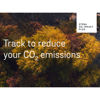
Try out Stena CO2 Impact Plus
Be a frontrunner and get ahead of the curve!
The pilot version of Stena CO2 Impact was launched in the autumn of 2023. The service will be made available to all our customers during the first quarter of 2024, to provide companies with an in-depth insight into their carbon dioxide emissions throughout the waste chain. Do you need to manage your business using detailed emissions data? And do you want to be among the first companies to try out the service pilot? Submit your interest here, and we will get back to you.




